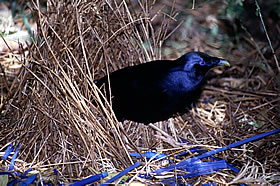Birdwatching

There is nothing quite like holding a pair of binoculars up to your eyes and 'transporting' a distant bird out of its own world and into your own personal space — revealing a kaleidoscope of colours, patterns, shapes and sizes. In Queensland this experience is made all the richer with around 600 of Australia's 800 species found here.
Starting out
Get yourself a bird book
A range of excellent field guides and books on Australian birds are in print (and even older out-of-print versions can be found in the second-hand bookshops). Which one you choose will depend on what information you're interested in. All will have good colour illustrations of birds while some will also have illustrations of nests and eggs and sections covering the life histories and behaviours of the different families of birds. Field guides will also give a phonetic description of a bird's call and this is often useful as birds are more often heard than seen (CDs of bird calls can also be bought).
The other consideration is size. If you're going to be carrying it with you or leaving it the glove box of a car, you should think about buying one of the smaller field guides. If it's going to be exposed to the weather and some rough treatment you may want to chose one with a sturdy, waterproof cover or cover it yourself.
Finally, when you do buy one, get to know where some of the birds can be found within the book so you can find the right pages quickly. You may even label some of the pages with names or coloured tags to help you find your bird more easily.
The more time you spend flicking through your field guide, the easier it will be to go to the right page — and the right bird — when you need to.
Choosing a pair of binoculars
Birdwatchers use a range of binoculars but generally go for ones with a 7–10 times magnification. The other consideration is the field of view (i.e. how wide an area is seen through the binoculars).
When you try out a pair of binoculars you will see that they have a pair of numbers written on them like 7x50 or 8x35. The first number refers to the magnification power of the binoculars and the second number indicates the size of the front lens. Generally speaking, the larger the second number, the wider the field of view (making it easier to find a bird through the binoculars) and the brighter the image will be (brightness is particularly important when light is poor due to the time of day, weather or when birdwatching in rainforest).
While larger magnifications may bring the birds closer, it also makes it harder to hold the binoculars steady. You may find that if you want to watch some types of birds (e.g. wading birds) you may need to use a spotting scope or high magnification binoculars mounted on a tripod.
Size and weight are also important considerations as you may find that you're carrying your binoculars for hours at a time.
Try out a pair of binoculars before you buy them. You will have to adjust the focus to suit your eyes first (see below).
For your eyes only — adjusting your binoculars
Close your right eye and focus the binoculars (with the central focusing wheel) on an object in the distance just using your left eye. Focus on something like a sign or a car number plate so you can accurately judge when it is in focus. Then, close your left eye and look at the same object with your right eye. Bring it into exact focus using the adjustable focus ring around the right eye piece. Then the binoculars are set for your eyes and you will only need to adjust the central focusing wheel when using them.
Check the adjustment occasionally to make sure it hasn't changed.
Look after your binoculars. Try not to bump them against hard objects as this can move the internal prisms out of alignment leaving you with a double image every time you look through them. Also the lenses should only be cleaned with a lens cloth and any dust or grit should be first blown off the lenses with a blower brush (used for cleaning camera lenses). When not in use keep your binoculars in their case.
Doing it!
You don't have to go far to find birds. Even in treeless backyards there will be something to watch - and even the most common bird seen through binoculars can reveal something of itself that you've never noticed before.
But if you want to see a particular species, you may need to visit a national park or local conservation reserve. You can use this website to find out what national parks are near you and print out a species list of the birds and other wildlife recorded on that park. You can also access bird lists for parks or smaller areas using WetlandMaps.
Morning and afternoon are the best times to watch birds (the 'dawn chorus' is a particularly special time to see and hear birds). 'Hot spots' for birds include places like waterholes, and flowering or fruiting trees and are good places for sitting quietly and waiting for the birds to come to you.
While it is tempting to lure birds in with food or by imitating calls, this creates a range of problems (see wildlife feeding) and you are interrupting the bird's normal behaviour. You may be stopping it from finding food and protecting its territory or its young, and putting it under unnecessary stress at the same time.